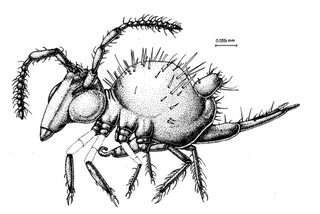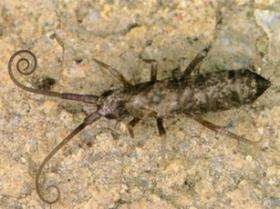New Genus of Collembola Named After College and Alumna

A Grinnell College biology professor has discovered a new genus of an extinct branch of the Collembola, a group of small arthropods partly responsible for the nutritious soil farmers enjoy.
The genus, located in amber discovered in Myanmar (Burma), is a relative of the more than 4,000 species of Collembola, also called springtails, found throughout the world today.
“The Collembola is a group often ignored and mostly misunderstood,” said Ken Christiansen, professor emeritus of biology at Grinnell College, Grinnell, Iowa, and a leading researcher of Collembola worldwide. “I feel certain that if Collembola were the size of cats there would be whole zoos devoted to them because they are so weird and varied. They are among the most numerous arthropods on earth’s surface, with as many as a trillion in an acre of soil.”
Christiansen and co-researcher Paul Nascimbene, associated with the American Museum of Natural History, New York, made the discovery of the extinct Collembola through painstaking analysis of amber samples dating from the mid-Cretaceous period, about 95 million years ago.

Recently published in the journal Cretaceous Research, the discovery puts Grinnell College and undergraduate research on the research map in a unique way. The new genus was named the Grinnellia ventis after Grinnell College, which supported this and much other research on Collembola, and a former student who assisted in the research, Summer Ventis, a 2002 Grinnell College graduate.
According to Christiansen, naming a new genus after an institution is fairly unusual, while naming a new discovery after a student is a more common practice among researchers.
“I feel very honored to have a species named after me,” said Ventis. “I think that the descriptions … will shed new light on questions about mass extinctions and about the evolution of Collembola.”
Species of living Collembola can be found
• above 21,000 feet on Mount Everest, Nepal.
• living in volcanic vents along Hawaii’s Kilauea, the world’s most active volcano.
• near the north and south poles and on sunny, warm beaches.
• in dark and damp caves throughout the world.
• from the tops of the tallest trees to the deepest soil layers that support animal life.
And some species are almost exclusively inhabitants of ant or termite nests.
“If you were to examine one of the columns of army ants which sweep across the floors of South American rain forests, you would often find Collembola marching along with them,” Christiansen said. “And one of the most remarkable habits of termite-loving Collembola is that some … have been observed sitting on the head of soldier termites. Soldiers are unable to feed themselves and when the workers feed them, the Collembola steal a bit of the food.”
The Grinnellia ventis was found in amber discovered in Myanmar where the fauna is superficially similar to what was found in the American Midwest. The rich amber fauna was a lucky find, according to Christiansen—even though many Collembola live in trees, not many specimens are found in the fossilized tree sap.
Wingless arthropods with six legs, superficially similar to insects but not related, the Collembola includes the common snow flea, which are most conspicuous when large numbers emerge on snow on a warm winter day. In addition, “the black speck on the paper in your home is one of a number of household springtails which have become part of man’s arthropod entourage,” Christiansen said.
According to Christiansen, the fact that they are so small (most are less than three millimeters long) and are no problem for humans accounts for a lack of general knowledge of the species.
Collembola have been on the earth for a long time—the first fossil specimens are about 380 million years old (Devonian period).
“The important role they have in recycling organic debris in the soil and the probably even more important role in maintaining fungal and nematode concentrations favorable to plant growth is poorly studied,” Christiansen said.
Although there are a few examples of Collembola, specifically the Lucerne Flea, that are agricultural pests—primarily in Australia where they are a serious pest of alfalfa—overall they are a harmless creature.
“There are no parasitic springtails of any sort,” according to Christiansen. “The Chinese Communists in the 1950s tried to accuse the U.S. of using bugs dropped from airplanes to spread disease in China. The picture they used as an example was of a mass of Collembola. They chose a group that has never been shown to carry disease. It was the only time I ever saw a picture of Collembola in a newspaper.”
For more on the Collembola go to www.collembola.org/
Source: Grinnell College















